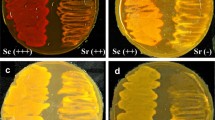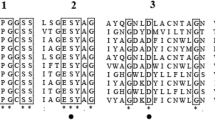Abstract
An aminopeptidase from the mycelia of Streptomyces rimosus was isolated in an electrophoretically homogeneous form. It was shown to be a monomeric, acidic protein (pI = 4.4, mol. wt. approx. 83,000), with optimal activity at pH 7.1–7.8 and at 35–41° C. The enzyme was fully inhibited by 0.1 mM EDTA or 1 mM o-phenanthroline; the activity was restored upon addition of 0.05 mM Co2+, Zn2+, or Ni2+. Amastatin, bestatin, and puromycin also inhibited the enzyme. The aminopeptidase hydrolyzed amino-acid-2-naphthylamides and various di- to heptapeptides. The highest catalytic coefficients (23 and 19 μM–1 s–1) were obtained with Arg- and Lys-2-naphthylamide, followed by Leu-, Phe- and Met-derivatives with one order of magnitude lower catalytic coefficients. Basic or bulky hydrophobic amino acids at the P1 and/or P1′ position of peptide substrates were preferred. Acidic amino acids and proline were not accepted. The affinity of the enzyme increased with the length of peptide. According to these properties, S. rimosus intracellular aminopeptidase is distinct from the extracellular leucine aminopeptidase of the same organism and can be classified as an Arg(Lys)-preferring metalloaminopeptidase.
Similar content being viewed by others
Author information
Authors and Affiliations
Additional information
Received: 18 January 1996 / Accepted: 19 March 1996
Rights and permissions
About this article
Cite this article
Vitale, L., Škrtić, I. & Abramić, M. An intracellular aminopeptidase from Streptomyces rimosus that prefers basic amino acids. Arch Microbiol 165, 409–414 (1996). https://doi.org/10.1007/s002030050345
Issue Date:
DOI: https://doi.org/10.1007/s002030050345




